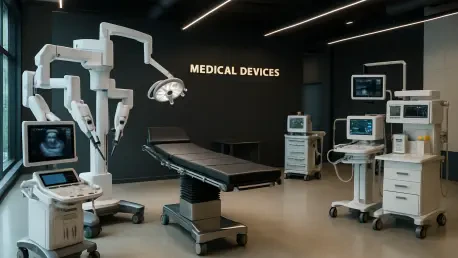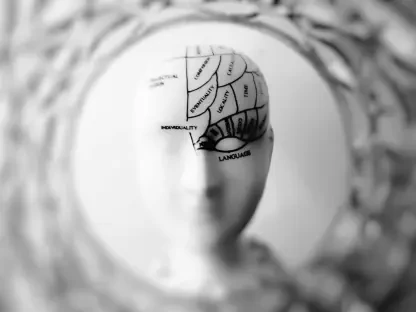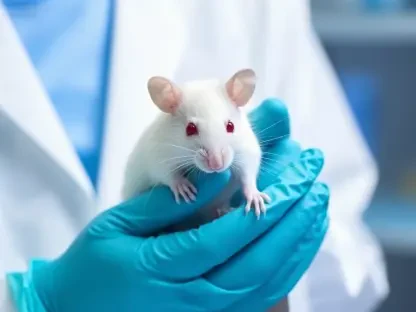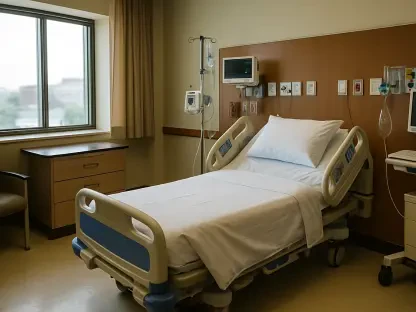Revolutionizing Healthcare Through Innovation Hubs
In an era where healthcare demands are escalating globally, medical devices stand as a cornerstone for transforming patient outcomes and streamlining medical processes with unprecedented precision. The emergence of dedicated innovation hubs, such as the Medical Devices Park (MDP) in Noida, India, signals a pivotal shift in addressing these challenges by fostering local manufacturing and reducing reliance on imported equipment. Located in Sector 28 of the Yamuna Expressway Industrial Development Authority (YEIDA) area, this hub is rapidly becoming a beacon of progress. This analysis delves into the strategic foundations of MDP, exploring its partnerships with academic institutions, infrastructure developments, technological integrations, expert perspectives, and future implications for the medical devices sector in India and beyond.
Building a Foundation for Innovation at Medical Devices Park
Growth and Development Metrics
The Medical Devices Park spans an impressive 350 acres, backed by a central government investment of Rs 440 crore, positioning it as a major national hub for medical equipment manufacturing. Recent updates from YEIDA reveal significant strides, with 101 industrial plots allocated to various stakeholders. Lease deeds for 23 projects have been finalized, while construction has commenced at seven key sites, including a substantial 11-acre plot for TI Medical, showcasing the scale of industrial engagement.
Further emphasizing momentum, building plans for 10 projects have been approved, reflecting a structured approach to development. A notable milestone was the inauguration of Krish Biomedicals on a 1,000-square-meter plot with an investment of Rs 6 crore, marking an early success in operationalizing the park. Reports from the Department of Pharmaceuticals highlight this rapid progress, positioning MDP as a critical player in enhancing India’s manufacturing capabilities.
Real-World Implementation and Early Successes
The transition from planning to execution at MDP is evident with Krish Biomedicals emerging as the first fully operational manufacturing unit within the park. This achievement underscores the tangible outcomes of strategic planning and investment, setting a precedent for other projects. The diversity of ongoing initiatives, with active construction across multiple sites, further illustrates the park’s dynamic environment.
Strategic plot allocations have played a vital role in fostering a collaborative ecosystem, accommodating both small-scale innovators and large industry players. This inclusive approach ensures a broad spectrum of expertise and resources, paving the way for a robust medical devices sector. The early traction at MDP signals a promising start, with the potential to inspire similar initiatives nationwide.
Strategic Partnerships with Academic and Technical Institutions
Collaboration with IIT Kanpur and Beyond
A cornerstone of MDP’s vision lies in its integration with premier academic bodies, notably the Indian Institute of Technology Kanpur (IIT-K). This partnership aims to infuse cutting-edge research and development (R&D) into the park’s operations, creating a synergy between theoretical knowledge and practical application. Senior officials from the Department of Pharmaceuticals have emphasized the urgency of such collaborations during recent review meetings, advocating for immediate ties with testing labs and domain experts.
The focus on embedding advanced research capabilities through these alliances is expected to elevate the park’s innovation quotient. Training programs developed in tandem with academic institutions will equip the workforce with specialized skills, ensuring sustainability. This strategic alignment aims to position MDP as a leader in medical device advancements, leveraging academic prowess for real-world impact.
Leveraging Expertise for Cutting-Edge Solutions
The expertise of IIT-K in fields like artificial intelligence (AI) and advanced materials offers immense potential for shaping R&D at MDP. These technologies could lead to breakthroughs such as AI-powered diagnostic tools or smart medical devices tailored for modern healthcare needs. The envisioned applications highlight a forward-thinking approach to tackling pressing medical challenges through innovation.
Beyond specific technologies, the broader goal is to merge academic insights with industrial execution, creating solutions that are both innovative and market-ready. This collaboration sets a model for how theoretical research can directly influence practical outcomes in healthcare. The anticipated outcomes include enhanced device functionality and accessibility, aligning with global healthcare demands.
Infrastructure and Technological Advancements
Role of Common Scientific Facilities (CSFs)
Central to MDP’s infrastructure are six Common Scientific Facilities (CSFs), designed to support innovation through shared resources. These include an Internet of Medical Things (IoMT) and AI Computing Center, a Bio-Material Testing Facility with a Gamma Irradiation Zone, and a Common Tooling Room equipped for 3D prototyping. Such facilities aim to lower operational costs for manufacturers by providing access to high-end testing and prototyping tools.
The CSFs also foster collaboration among stakeholders, enabling smaller firms to leverage advanced infrastructure alongside larger corporations. This shared ecosystem is crucial for driving collective progress in medical device development. By positioning these facilities at the core of operations, MDP ensures it remains at the forefront of technological innovation.
Embracing Modern Healthcare Technologies
A key focus at MDP is the integration of modern technologies like AI, IoMT, and advanced materials into its framework, as advocated by officials such as Secretary Amit Agrawal. These advancements promise to create connected, data-driven devices that improve patient care and optimize healthcare delivery systems. The emphasis on smart technology reflects a proactive stance in meeting evolving medical needs.
This technological direction aligns closely with global trends toward digitization and smart healthcare solutions, ensuring relevance on an international scale. The potential to develop devices that offer real-time data and enhanced functionality positions MDP as a pioneer in the sector. Such innovations are set to redefine standards of care, making healthcare more efficient and accessible.
Insights from Industry and Government Leaders
Perspectives from key figures, including Secretary Amit Agrawal and Joint Secretary Aman Sharma of the Department of Pharmaceuticals, underscore the critical role of academic-industry collaboration in MDP’s success. Their vision emphasizes building an ecosystem where research directly translates into industrial innovation, strengthening India’s position in the global medical devices market. This unified stance highlights the strategic importance of such partnerships.
Additionally, YEIDA CEO Rakesh Kumar Singh has provided updates on infrastructure advancements, noting the steady progress in plot allocations and construction activities. These operational milestones reinforce confidence in the park’s trajectory. The consensus among government, industry, and academic leaders points to MDP as a transformative hub, poised to elevate national competitiveness through collaborative efforts.
Future Prospects and Broader Implications
Looking ahead, MDP holds the potential to become a national epicenter for medical device innovation, significantly cutting down India’s dependence on imported equipment over the coming years. Anticipated growth includes scaling up manufacturing capacity and attracting further investments, which could amplify the park’s impact. The expansion of technological research through CSFs and academic partnerships is expected to drive continuous advancements.
However, challenges such as ensuring seamless coordination between academia and industry, securing sustained funding, and attracting top talent remain critical hurdles. Addressing these will be essential for maintaining momentum. On the positive side, enhanced access to locally produced devices could revolutionize healthcare delivery, while global market competition poses a risk that demands strategic navigation.
Reflecting on a Transformative Journey
Reflecting on the journey, the Medical Devices Park in Noida has carved a path of innovation through strategic vision, robust partnerships with institutions like IIT Kanpur, and significant infrastructure milestones. The integration of cutting-edge technologies marked a bold step toward redefining healthcare manufacturing in India. Government and industry collaboration proved instrumental in laying this groundwork.
Moving forward, stakeholders must prioritize sustained investment and streamlined coordination to overcome potential obstacles. Establishing talent pipelines and fostering global partnerships could further solidify MDP’s standing. These actionable steps promise to ensure that the initiative not only meets national needs but also contributes to a healthier, more self-reliant global healthcare landscape.









